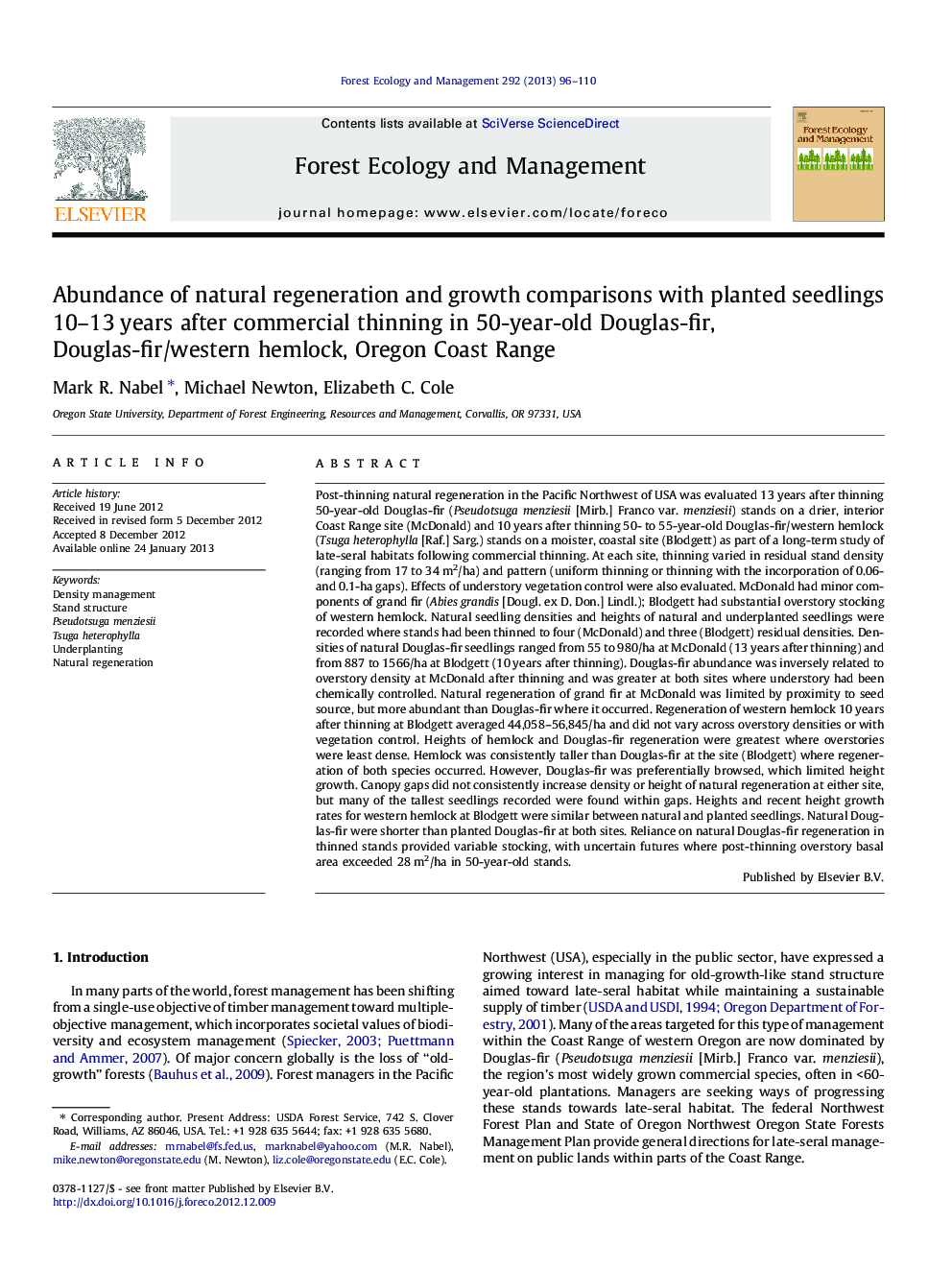| کد مقاله | کد نشریه | سال انتشار | مقاله انگلیسی | نسخه تمام متن |
|---|---|---|---|---|
| 87116 | 159232 | 2013 | 15 صفحه PDF | دانلود رایگان |

Post-thinning natural regeneration in the Pacific Northwest of USA was evaluated 13 years after thinning 50-year-old Douglas-fir (Pseudotsuga menziesii [Mirb.] Franco var. menziesii) stands on a drier, interior Coast Range site (McDonald) and 10 years after thinning 50- to 55-year-old Douglas-fir/western hemlock (Tsuga heterophylla [Raf.] Sarg.) stands on a moister, coastal site (Blodgett) as part of a long-term study of late-seral habitats following commercial thinning. At each site, thinning varied in residual stand density (ranging from 17 to 34 m2/ha) and pattern (uniform thinning or thinning with the incorporation of 0.06- and 0.1-ha gaps). Effects of understory vegetation control were also evaluated. McDonald had minor components of grand fir (Abies grandis [Dougl. ex D. Don.] Lindl.); Blodgett had substantial overstory stocking of western hemlock. Natural seedling densities and heights of natural and underplanted seedlings were recorded where stands had been thinned to four (McDonald) and three (Blodgett) residual densities. Densities of natural Douglas-fir seedlings ranged from 55 to 980/ha at McDonald (13 years after thinning) and from 887 to 1566/ha at Blodgett (10 years after thinning). Douglas-fir abundance was inversely related to overstory density at McDonald after thinning and was greater at both sites where understory had been chemically controlled. Natural regeneration of grand fir at McDonald was limited by proximity to seed source, but more abundant than Douglas-fir where it occurred. Regeneration of western hemlock 10 years after thinning at Blodgett averaged 44,058–56,845/ha and did not vary across overstory densities or with vegetation control. Heights of hemlock and Douglas-fir regeneration were greatest where overstories were least dense. Hemlock was consistently taller than Douglas-fir at the site (Blodgett) where regeneration of both species occurred. However, Douglas-fir was preferentially browsed, which limited height growth. Canopy gaps did not consistently increase density or height of natural regeneration at either site, but many of the tallest seedlings recorded were found within gaps. Heights and recent height growth rates for western hemlock at Blodgett were similar between natural and planted seedlings. Natural Douglas-fir were shorter than planted Douglas-fir at both sites. Reliance on natural Douglas-fir regeneration in thinned stands provided variable stocking, with uncertain futures where post-thinning overstory basal area exceeded 28 m2/ha in 50-year-old stands.
► We evaluated natural regeneration 10 or 13 years after thinning.
► Shade-tolerant western hemlock regenerated readily.
► Western hemlock dominated Douglas-fir across the range of treatments.
► Seedlings were taller under lower overstory densities.
► Heights for western hemlock were similar between natural and planted seedlings.
Journal: Forest Ecology and Management - Volume 292, 15 March 2013, Pages 96–110